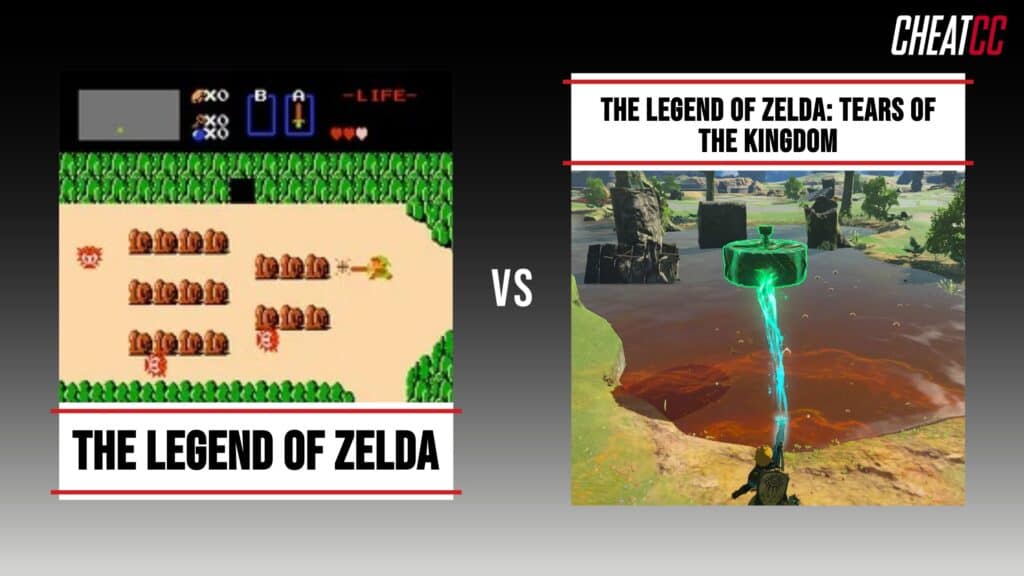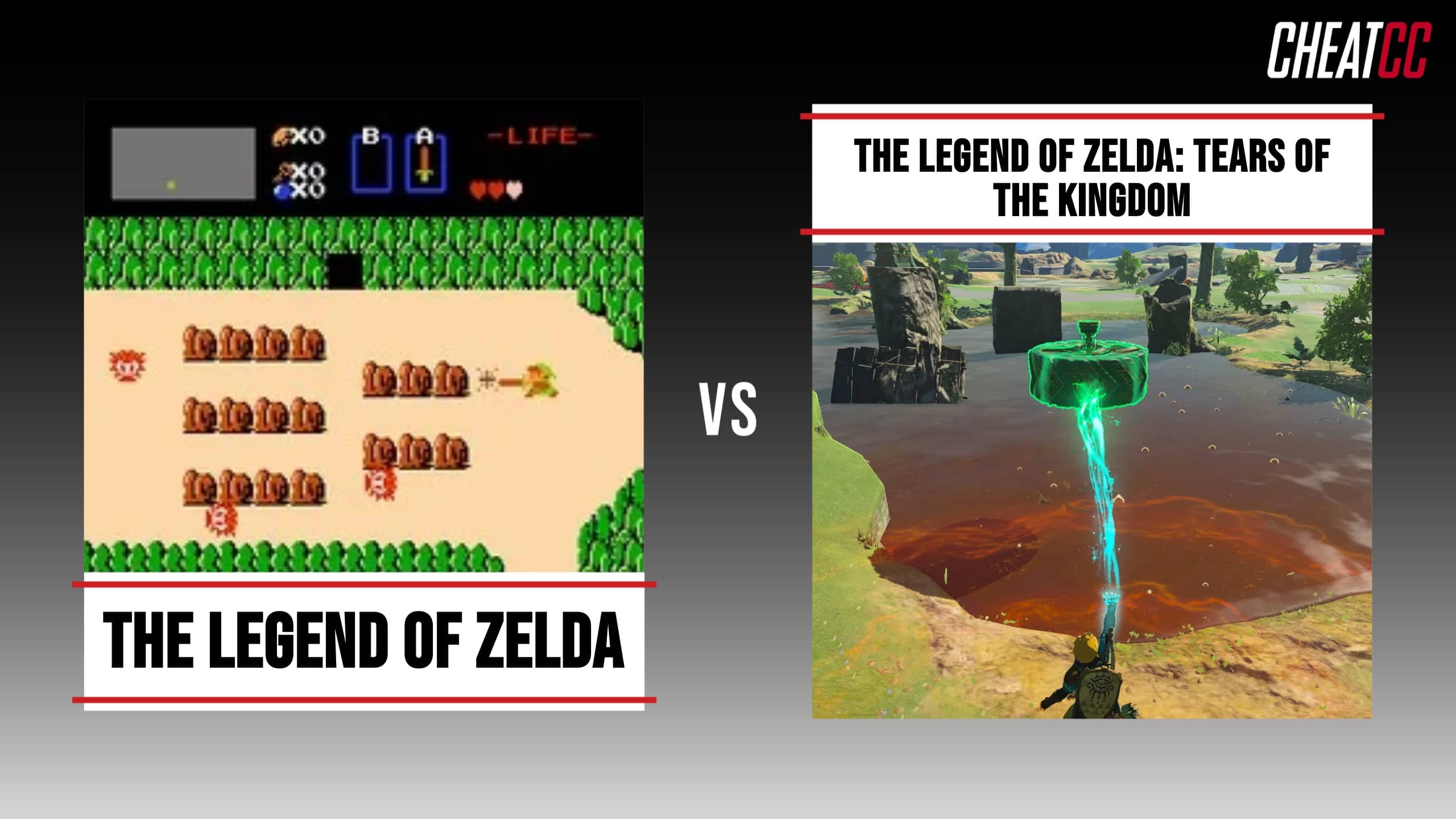More than 35 years since its initial outing on the Famicom/NES, The Legend of Zelda series continues to represent one of the core pillars of the video game industry. The latest game in the franchise, The Legend of Zelda: Tears of the Kingdom, radically reinvents the franchise much in the same way that its predecessor, Breath of the Wild, did back in 2017. With a series as groundbreaking as the Zelda franchise, each mainline entry represents a conscious evolution of the core mechanics and elements that are synonymous with its action-adventure gameplay, which in turn go on to influence nearly every other action-adventure game releasing in their stead. The original Legend of Zelda actually features a prototypical open-world, which makes it a fitting candidate for a battle of The Legend of Zelda vs Zelda: Tears of the Kingdom to see which has the better sandbox for players to explore.
Of course, Tears of the Kingdom has the benefit of releasing on hardware vastly more powerful than the NES. Additionally, TotK draws on more than 15 mainline entries’ worth of inspiration and iteration to create what is arguably the most abitious Zelda title to-date. In comparison, The Legend of Zelda is both the first game in the series and the foundation on which its legacy continues to evolve. That said, there’s something to be said regarding the importance of both games in the course of the franchise’s history. Just because one game features a revolutionary open world, that in no way diminishes the importance of the original Zelda‘s revolutionary approach to an action-adventure game.
The Legend of Zelda vs Zelda: Tears of the Kingdom: Side-by-Side Comparison

Releasing 37 years apart, The Legend of Zelda and Zelda: Tears of the Kingdom are interesting bookends to the franchise that showcase nearly 40 years of continued evolution and iteration of one of gaming’s most important franchises. Tears of the Kingdom builds on the incredible open-world sandbox of its predecessor to implement new game-changing mechanics such as Ultrahand, Fuse, and Ascend. Conversely, the original Legend of Zelda is a groundbreaking title in the history of both Nintendo and the NES, showcasing the power and potential of home consoles at a time when the video game industry was just starting to come back to life in the West. As both the first and the most recent titles in the franchise, the original Legend of Zelda and Tears of the Kingdom rank among some of the most important games in the series.
| Characteristic | The Legend of Zelda | Zelda: Tears of the Kingdom |
|---|---|---|
| Release Date | February 21, 1986 (Famicom) August 22, 1987 (NES) | May 12, 2023 |
| Release Platform | Famicom/NES | Nintendo Switch |
| Director | Shigeru Miyamoto Takashi Tezuka | Hidemaro Fujibayashi |
| Producer | Shigeru Miyamoto | Eiji Aonuma |
| Review Aggregate Score | 90% | 96% |
| Total Sales | 6.51 million units | 20.28 million units |
| Game World | Open-world map | Open-world map with 3 distinct biomes |
| Progression | Non-linear | Non-linear |
| Unique Mechanics | Open-ended exploration, save system, plethora of secrets | Ultrahand mechanic allows building and crafting, Fuse allows players to create powerful weapons, Ascend can creatively sequence break traversal |
| Graphical Style | 2D Pixel Art | Full 3D, Cel-Shading |
| Place in the Franchise | Original game, first title in the franchise | Most recent franchise entry, final Zelda game for the Nintendo Switch |
The Legend of Zelda vs Zelda: Tears of the Kingdom: 5 Must-Know Facts
Here are 5 must-know facts when comparing the open worlds of The Legend of Zelda and Tears of the Kingdom:
- Even though it’s the first game in the series, The Legend of Zelda is actually the last entry to implement an early open-world, non-linear structure until Breath of the Wild. On the other side of the coin, Tears of the Kingdom pushes the envelope of what’s possible in an open-world Zelda game.
- The open-world that The Legend of Zelda drops players into is one of the earliest examples of a completely open, non-linear structure for an adventure game. Where most games of the era would require players to make their way through linear challenges, The Legend of Zelda gives players freedom to explore.
- As the first game in the series, Zelda creator and longtime Nintendo luminary Shigeru Miyamoto would handle most of the directorial and game design duties. Conversely, Tears of the Kingdom and its predecessor Breath of the Wild are the brainchild of the modern series mastermind, Eiji Aonuma.
- Both The Legend of Zelda and Zelda: Tears of the Kingdom are critically successful, earning high marks and praise from nearly every reviewer. Where the games mostly differ is in their commercial success, with the install base of the Nintendo Switch helping Tears of the Kingdom to sell almost 15 million units more than the original Legend of Zelda.
- Breath of the Wild and Tears of the Kingdom each owe a debt of gratitude to the original Legend of Zelda, as both games continue the open-ended freedom, player expression, and spirit of exploration that defines that all-time classic.
The Legend of Zelda vs Zelda: Tears of the Kingdom: First vs Best
Though the original Legend of Zelda implements an open, non-linear structure to its adventure, the most recent Zelda game arguably perfects the series’ open-world formula. Tears of the Kingdom takes the open-world sandbox of Breath of the Wild and expands upon it in meaningful ways to provide players with the most feature-rich and engaging open world the series has ever seen. Between the ability to craft almost anything the player can imagine with Ultrahand and the ways that the player can sequence break and make the game less challenging with both Fuse and Ascend, Tears of the Kingdom showcases almost 4 decades of series evolution and refinement.
The Legend of Zelda vs Zelda: Tears of the Kingdom: Proto Open-World
Despite the fact that Tears of the Kingdom represents the pinnacle of the Zelda series’ forays into open-world game design, the original Legend of Zelda establishes the foundation on which both Breath of the Wild and Tears of the Kingdom are built. The Legend of Zelda‘s Hyrule is what can be considered a “proto” open-world, establishing the core elements of open-world game design before the industry would even develop the terminology.
Players drop into Hyrule with no official direction and are free to go anywhere they choose. The game gives players subtle environmental cues that help to push them in the most desirable direction, but ultimately, Link is free to tackle most of the world’s challenges in any order the player sees fit. The only constraint on where a player can go is the need for certain items to cross bodies of water or having to collect the pieces of the Triforce before entering Death Mountain.
The Legend of Zelda vs Zelda: Tears of the Kingdom: Different Generations of Series Masterminds
After serving as one of the creative forces behind Nintendo’s breakout arcade hit Donkey Kong, Shigeru Miyamoto would create both Super Mario Bros. and The Legend of Zelda. In the process, Miyamoto’s design sensibilities would come to define the unique spirit of Nintendo first-party games and help to elevate the company and its hardware to supremacy across mutliple hardware generations. During the development of Zelda‘s first 3D entry, Ocarina of Time, Miyamoto would pass the proverbial torch of the Zelda series’ stewardship to Eiji Aonuma, who now serves as the current guiding hand of the Zelda franchise. Both Breath of the Wild and Tears of the Kingdom represent a conscious desire on the part of Aonuma to return to the freeform exploration and adventure of the original Legend of Zelda.
The Legend of Zelda vs Zelda: Tears of the Kingdom: Critical and Commercial Reception
Despite the fact that we now look back on the original Legend of Zelda as one of the best and most important video games to ever release, its critical reception at the time paints a picture of the title being excellent, but nothing revolutionary. With a review aggregate score of 90% according to an average of the print reviews at the time, The Legend of Zelda has a relatively cool critical reception in comparison to the response to Ocarina of Time, Breath of the Wild, and Tears of the Kingdom. Further, the medium of video games was still experiencing a period of growth at the time of the original Legend of Zelda‘s release, whereas now it sits as one of the most important entertainment industries.
Tears of the Kingdom is both the fastest-selling Zelda title and the fastest-selling Nintendo Switch game of all-time. The title currently has sales of almost 21 million units to its name, and that figure is sure to continue to grow as the title continues to reach new audiences thanks to its excellent open-world and series-first crafting mechanics. Breath of the Wild may be the most successful Zelda title of all-time, but there’s every indication that Tears of the Kingdom‘s continued success will see it eventually overtake its predecessor.
Bottom Line
There’s no denying the importance of the original Legend of Zelda or the great strides it makes toward revolutionizing game design. That said, Tears of the Kingdom is something of a miraculous achievement on the part of Nintendo EAD and Eiji Aounuma, completely recontextualizing what’s possible in terms of an open-world Zelda adventure. The Ultrahand mechanic alone takes the Zelda franchise in exciting new directions in terms of its potential growth and evolution, and the open-world sandbox in Tears of the Kingdom is absolutely the best in the series (and, arguably, one of the best open-worlds in gaming, period). The Legend of Zelda might be the original game in the franchise and the first to implement a non-linear, open structure to its gameplay, but Tears of the Kingdom is about as close to a “perfect” open-world Zelda as one can get.
